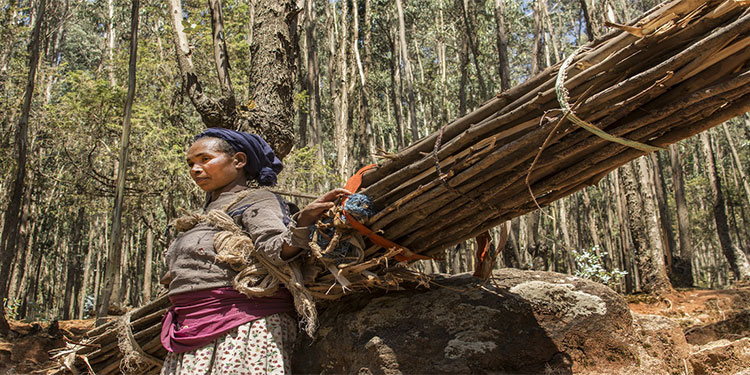
Billions of bees are hard at work in Kaffa, producing honey and beeswax for a 3,500-person workforce. Another Addis Abeba-based company harvests bamboo for furniture, contributing 2.6 million USD (91 million birr) to the national economy. Forest products grown by businesses and communities contribute more than 2.6 billion USD (91 billion birr) to Ethiopia’s GDP.
Local communities have planted millions of trees and bamboo clusters to restore their farms, forests, and pastures. For decades, annual soil and water conservation campaigns rewarded locals who cared for the land.
Ethiopia’s government recently increased its commitment to the pan-African AFR100 Initiative by pledging to restore 15 million hectares of land by 2030.
We know that more trees could benefit 73 percent of Ethiopia’s land, but how can the government, communities, and businesses turn this opportunity into economic prosperity?
The opportunity is clear: Ethiopian demand for wood and forest products is expected to rise by 27% over the next 20 years. Forests already account for 12.9 percent of national GDP, and an estimated 57 million people — more than half of the country’s population — work full- or part-time in the forest sector. More than 11 million rural households rely almost entirely on forests for survival.
This figure is expected to rise as the COVID-19 crisis threatens the jobs of an estimated 1.5 million Ethiopians, the majority of whom are urban poor. Many of them will return to their rural homelands in search of new jobs and opportunities. Fortunately, the forest sector can help fill that void, and the government is supportive.
The National Forest Sector Development Program (NFSDP) aims to create 630,000 full-time rural jobs by assisting people in managing tree nurseries, planting seedlings, protecting forests, and marketing forest products. The forest sector is also important in Ethiopia’s Climate Resilient Green Growth (CRGE) Strategy, which outlines a path for the country to reach middle-income status by 2025. Protecting the remaining 17.35 million hectares of forest and restoring forest cover to 30% are critical components of that vision.
Trees, Forests, and Profits in Ethiopia, a new report from the Environment, Forest, and Climate Change Commission (EFCCC) and World Resources Institute, shows that we can help meet these economic targets by sustainably managing trees across 1 million hectares of existing private/communal/state-owned production forests, plus 310,000 hectares of new forest plantations. The establishment of those new plantations would necessitate a significant private investment of 638 million USD, but could yield a return of 1.91 billion USD (69 billion birr), or 3 USD for every 1 USD invested.
Two commercial forestry enterprises run by the governments of Oromia and Amhara are taking advantage of this opportunity. Oromia Forest and Wildlife Enterprise and Amhara Forest Enterprise use an out-grower scheme to engage smallholder farmers, creating jobs and generating annual revenues of 10.5 million USD (364 million birr) and 4.5 million USD (164 million birr), respectively. Similar businesses have enormous potential for growth. The country has approximately 26.8 million ha of suitable land for new commercial forests and 190,000 ha of state-owned plantations available for development or improved management in various regions.
In Ethiopia, private entrepreneurs are also working to restore land for profit while reducing pressure on standing forests.They are developing green jobs, including for women and young people, as well as sustainable value chains and reliable markets for rural households to increase their income.
Thousands of farmers cultivate bamboo in Ethiopia, but many do not have access to a manufacturing facility that can provide them with a consistent income from their crop. SA Bamboo Works, founded by Addisu Hailu in Addis Abeba, is one of the few Ethiopian bamboo manufacturing companies that produces for both domestic and international markets. The company generates 2.8 million USD in annual revenue, employs 300 people in its furniture factories, and obtains raw bamboo from hundreds of individual farmers and cooperatives. The bamboo seedlings that they plant also help to restore the land by retaining water in the soil and halting erosion.
Many people are unsure of how to turn their ideas into a profitable business model. Ethiopian expertise is not tailored to respond to the specific priorities of restoration startups, and it does not reach a diverse range of potential entrepreneurs in universities and regions.
Ethiopians have demonstrated in recent years a desire to plant trees and protect forests. Now is the time to assist them in turning their dream into a profitable reality and creating a thriving new forest economy.



